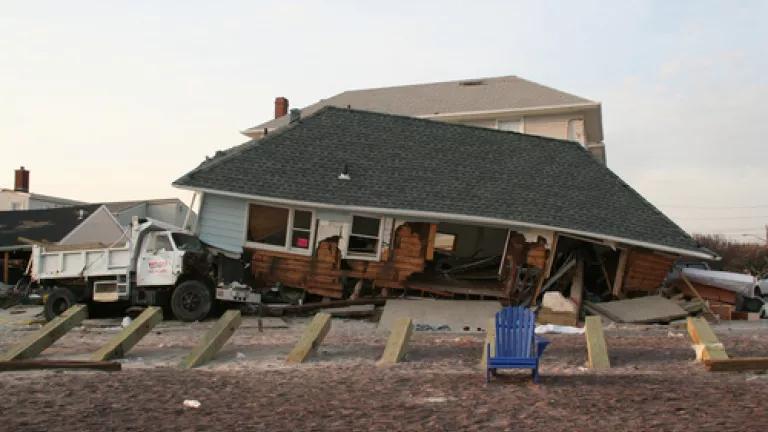
It’s been nearly a year since Superstorm Sandy crashed into the heart of the Northeast, killing more than 100 people and causing more than $60 billion in damage in New York and New Jersey alone. The storm’s toll made one thing abundantly clear: climate change is here, its costs are already high, and they are likely to climb higher soon.
NRDC's New York team took stock of Sandy's destruction in places like the Rockaways.
So now, a year after the biggest extreme weather disaster to pummel the metropolitan area, it might be a good time to ask: What have local leaders done to prepare the city, the state, and the region, for climate change and the extreme weather it brings, and to cut back on the carbon pollution that is driving it? What is the plan? Is it ambitious enough? Is it working? Or, as the late mayor Ed Koch might have put it, “How’re we doin’?”
In a nutshell, I’d say we’re doin’ pretty well—and that we can, and should, do better. From my years of experience in state and city government, I can vouch for the fact that this region has a history of enlightened thinking about climate change (merely embracing the term puts us ahead of much of the country), and recent efforts—particularly in energy efficiency—have continued in that proactive vein. In many ways, this region—with its high density population, intensive coastline development and extensive demands for energy--has become the epicenter of the American environmental challenge. So as America ramps up to combat climate change in earnest, what we do here—and how well we do it--is a model for climate change action nationwide.
Let’s take a look at the response to Sandy. Once cleanup and recovery operations from the storm were underway, leaders pivoted to prevention. In February, New York Governor Andrew Cuomo announced a $400-million floodplain buyout program that would lower the number of residents and businesses in the most vulnerable areas and convert the purchased properties into parkland, wetlands, and dunes that would serve as sponges in future disasters. A few months later, New York City Mayor Michael Bloomberg unveiled a $20 billion plan to make the city more resilient to the inevitable effects of climate change.
PlaNYC, a comprehensive blueprint to create a more sustainable city, including a goal of cutting the city's carbon emissions by 30 percent. To that end, New York City has become a leader on building energy efficiency, creating innovative models, such as the New York City Energy Efficiency Corporation, which is helping buildings retrofit to save energy, and adopting the most comprehensive set of initiatives to cut energy consumption in large buildings.

Efficiency is one of the most powerful and cost-effective tools at our disposal to combat climate change. Our success depends on it. New York City’s Greener, Greater Buildings Plan aims to cut the energy waste in the city’s thousands of residential and commercial buildings, whose energy use accounts for 75 percent of the city’s greenhouse gas emissions. So far, according to the most recent report, the city has “benchmarked” (measured the baseline energy use of) almost two billion square feet of real estate, made dozens of city code provisions greener, increased solar capacity more than 10-fold, and covered more than 3.5 million square feet of roofs with reflective white coating that cuts cooling costs. The city has completed efficiency retrofits on 174 of its own buildings, for an annual savings of $6.4 million in energy expenses—just one element of a comprehensive effort to “lead by example” and reduce emissions from its own operations 30 percent by 2017.
New York State has demonstrated leadership on reducing emissions through additional clean energy initiatives, including the state’s “Build Smart” program to save energy in state-owned and state-managed buildings. Governor Cuomo has committed to create an innovative Green Bank to leverage private financing to advance renewable energy and energy efficiency. In addition, the governor has committed to extending for a full decade New York’s successful NY-Sun Initiative, a public-private partnership promoting solar power.
Of course, the region’s biggest initiative to combat carbon pollution is the Regional Greenhouse Gas Initiative (RGGI). Launched in 2006, under then-Governor George Pataki, RGGI was the first market-based regulatory program in the country, which caps and reduces power-plant carbon pollution in nine Northeastern states.
In the five years that it has been fully operating, RGGI has helped reduce power-plant carbon pollution by 30 percent—even as the regional economy has grown by 20 percent.
RGGI features an auction system for carbon allowances—the quarterly June bidding brought in $124.4 million—that lets the market determine the most cost-effective way to cut power-plant pollution.
RGGI has already kept $765 million in the economies of the nine participating states—Maine, Vermont, New Hampshire, Massachusetts, Rhode Island, Connecticut, New York, Delaware and Maryland—by reducing the amount consumers pay for energy, most of which is paid to out-of-state fossil-fuel suppliers. In addition, by investing the income from the sale of allowances into actions such as making homes and buildings more efficient—creating an estimated 16,000 good job-years of work that must be done in-state—RGGI will save consumers $1.3 billion on energy bills.
With RGGI, our region has demonstrated that cutting carbon pollution from existing power plants is not only feasible, but economical. The national effort to set similar limits will build on this important work. RGGI did suffer a setback two years ago when New Jersey Gov. Chris Christie pulled out of the interstate compact, denouncing it as a “tax.” But New Jersey’s emissions continue to fall, and earlier this year, the member states made some important mid-course corrections, setting lower pollution limits to get the targets back in sync with actual emissions.
On climate change, it’s fair to say New York is doin’ pretty well. Our political leaders have consistently taken a proactive approach to reducing risks and preparing for climate change. But we can’t afford to rest on our laurels now. There’s plenty of scope for improvement, and ways to build on our earlier success. New priorities on the region’s clean energy agenda should include:
• Accelerating the shift to clean energy by improving siting processes for wind and leveraging the purchasing power of the city and large entities to create market incentives for the construction of renewable energy facilities.
• Proceeding with plans to build a 350 megawatt wind project off Long Island.
• Extending and increasing New York’s Renewable Portfolio Standard to 50 percent by 2025.
• Building upon New York’s Energy Efficiency Portfolio Standard to reduce electricity consumption an additional 20 percent by 2025.
The New York City region can contribute to global and national challenges as it has in the past—by being a leader locally and regionally. Maintaining the momentum we have built is our next challenge.
Next up: a look at more state and city efforts to address sustainability more broadly throughout the region.
(This post is adapted from an article that first appeared in the Washington Spectator.)
